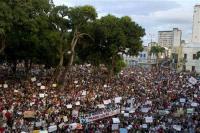Brazil went to the streets in June this year with crowds never before seen in the history of the country. There were young workers and students who were demonstrating for the first time, but also sectors of the middle class and union members as well as social movement and left party activists who protested about a wide diversity of issues.
Brazilian Spring: a general panorama and some perspectives
[Mass protests have been taking place in all the major cities of Brazil for the past week, beginning with a demand to reduce bus fares and expanding into a mass movement that demands improvements in all public services, health, education, and working peoples’ rights.
The End of Lethargy in Brazil
 Our country was at the forefront of social and political struggles in the 1980s, and succeeded in preventing the introduction of neoliberalism in Brazil, so that Latin America’s “lost decade” was, for social movements and popular politicians in our country, exactly the opposite.
Our country was at the forefront of social and political struggles in the 1980s, and succeeded in preventing the introduction of neoliberalism in Brazil, so that Latin America’s “lost decade” was, for social movements and popular politicians in our country, exactly the opposite.
Strike Wave Sweeps Brazil: No Sector Unaffected; A New Union Movement On the March
Workers in Brazil—in heavy industry, services, the public sector, and agriculture—are involved in a series of strikes and mass protests such as the country hasn’t seen in decades. . Driving the new labor upsurge is the strength of the country’s economy, the powerful position of unions in the society, and the rising inflation. In 2007 and 2008, Brazil’s economy grew at a rate of 5%, and though in the depths of the crisis in 2009 it shrunk by .02%, last year the economy grew again at a rate of 10%.
